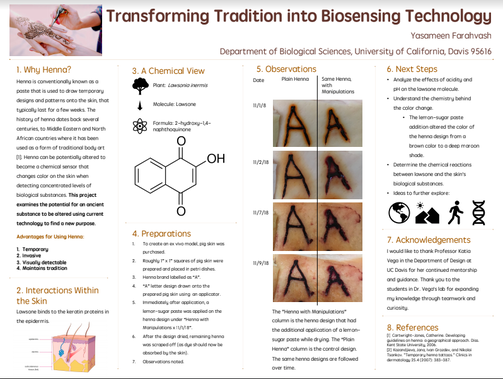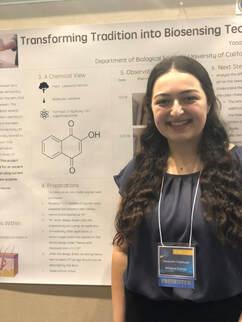Research - 2020
The Potential of Interactions Through Temporary Biosensing Pigments
Designer: Yasameen Farahvash
Sponsor: Katia Canepa Vega, Ph.D.
Sponsor: Katia Canepa Vega, Ph.D.
Abstract: The exterior surface of the body provides a platform to obtain information about the inner, biological functions. Wearable technology has enhanced the use of non-invasive devices on the skin for electrochemical tracking of biological processes through data output. Similar research reveals a novel approach to permanent pigments, similar to tattoos, that can interact within the skin. This project investigates the potential of a temporary tattoo molecule, such as lawsone, to be implemented as a natural dye biosensor to reveal information about the body through interactions within the epidermis. Lawsone, also known as henna, is used as a paste that binds to the keratin proteins in the outermost layer of skin and is faded over time as the skin sheds and interacts with the environment. In the lab, experiments using an ex vivo model (pig skin) were conducted by modifying the appearance of the lawsone molecule with different substances, such as acidic manipulations for alterations in color. This project proposes the possibility of extending the functionality of henna from a traditional pigment to a chemical sensor in order to create an interactive display within the skin.



Interacting with a Cat to Intertwine Virtual Reality and Physical Objects
Designer: Sonia Puertas Acosta
Sponsor: Katia Canepa Vega, Ph.D.
Winter 2020
Sponsor: Katia Canepa Vega, Ph.D.
Winter 2020
Abstract: In recent years, emotional support animals have shown to be effective at decreasing stress and depression as animals promote self-confidence, peace of mind, greater independence, a sense of safety, and enhanced social interaction. Japanese Neko cafés allow clients to drink coffee while petting cats, creating a stress-free environment. Similarly, Virtual Reality projects such as The Kitties in Virtual Reality app aim to relief its user by watching cats interacting with each other in a virtual world. Furthermore, cat robots such as Joy for all cats and companion pets have been created to simulate the interactions between cats and users. Through Virtual Reality and the use of haptic devices, this project intertwines the sense of presence between the virtual and physical world. Users would interact with cats by wearing Virtual Reality headsets and petting a haptic device that would reflect what the user sees, hears, and touches in the virtual world.



